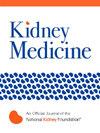IgA Nephropathy: An Overview of the Clinical Trials
IF 3.4
Q1 UROLOGY & NEPHROLOGY
引用次数: 0
Abstract
IgA nephropathy (IgAN) is characterized by the deposition of poorly-O-galactosylated IgA1 (also referred to as galactose-deficient IgA1 or gd-IgA1) containing immune complexes in the glomerular mesangium. This triggers a variable degree of glomerular inflammation that leads to progressive kidney damage and often kidney failure. The acceptance of proteinuria reduction as a reasonably likely surrogate end point for treatment effects on progression to kidney failure has led to many clinical trials evaluating novel and repurposed therapies for IgAN. New treatments leverage different aspects of IgAN pathophysiology, including the modulation of mucosal immunity, mechanisms of B-cell activation, and complement activity. The approval of the first treatments evaluated specifically for IgAN (including delayed-release budesonide, sparsentan, atrasentan, and iptacopan) represent meaningful advancements in the management landscape, and promisingly, many more treatments seem poised to arrive. This review compiles a list of current active trials for IgAN and highlights the necessity for ongoing research to optimize therapeutic strategies to further improve outcomes for those living with IgAN.
IgA肾病:临床试验综述
IgA肾病(IgAN)的特征是含有免疫复合物的o -半乳糖基化IgA1(也称为半乳糖缺乏IgA1或gd-IgA1)在肾小球系膜沉积。这会引发不同程度的肾小球炎症,导致进行性肾损害,常常导致肾衰竭。接受蛋白尿减少作为治疗进展为肾衰竭效果的合理可能的替代终点,导致许多临床试验评估IgAN的新疗法和重新定位疗法。新的治疗方法利用了IgAN病理生理的不同方面,包括粘膜免疫的调节、b细胞活化的机制和补体活性。第一批专门针对IgAN的治疗方法(包括延迟释放的布地奈德、斯帕森坦、阿特拉森坦和伊他科潘)的批准代表了管理领域有意义的进步,而且有希望的是,更多的治疗方法似乎即将到来。本综述汇编了目前IgAN的积极试验列表,并强调了持续研究的必要性,以优化治疗策略,进一步改善IgAN患者的预后。
本文章由计算机程序翻译,如有差异,请以英文原文为准。
求助全文
约1分钟内获得全文
求助全文

 求助内容:
求助内容: 应助结果提醒方式:
应助结果提醒方式:


